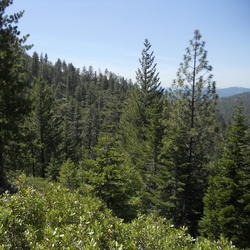A short video on how carbon can get into the atmosphere.
How much carbon dioxide does the United States and the World emit each year from energy sources?
The U.S. Energy Information Administration estimates that in 2019, the United States emitted 5,130 million metric tons of energy-related carbon dioxide, while the global emissions of energy-related carbon dioxide totaled 33,621.5 million metric tons.
Related
What is carbon sequestration? What is carbon sequestration?
Carbon dioxide is the most commonly produced greenhouse gas. Carbon sequestration is the process of capturing and storing atmospheric carbon dioxide. It is one method of reducing the amount of carbon dioxide in the atmosphere with the goal of reducing global climate change. The USGS is conducting assessments on two major types of carbon sequestration: geologic and biologic.
What’s the difference between geologic and biologic carbon sequestration? What’s the difference between geologic and biologic carbon sequestration?
Geologic carbon sequestration is the process of storing carbon dioxide (CO2) in underground geologic formations. The CO2 is usually pressurized until it becomes a liquid, and then it is injected into porous rock formations in geologic basins. This method of carbon storage is also sometimes a part of enhanced oil recovery, otherwise known as tertiary recovery, because it is typically used later in...
How does carbon get into the atmosphere? How does carbon get into the atmosphere?
Atmospheric carbon dioxide comes from two primary sources—natural and human activities. Natural sources of carbon dioxide include most animals, which exhale carbon dioxide as a waste product. Human activities that lead to carbon dioxide emissions come primarily from energy production, including burning coal, oil, or natural gas. Learn more: Sources of Greenhouse Gas Emissions (EPA)
How much carbon dioxide can the United States store via geologic sequestration? How much carbon dioxide can the United States store via geologic sequestration?
In 2013, the USGS released the first-ever comprehensive, nation-wide assessment of geologic carbon sequestration, which estimates a mean storage potential of 3,000 metric gigatons of carbon dioxide. The assessment is the first geologically-based, probabilistic assessment, with a range of 2,400 to 3,700 metric gigatons of potential carbon dioxide storage. In addition, the assessment is for the...
Which area is the best for geologic carbon sequestration? Which area is the best for geologic carbon sequestration?
It is difficult to characterize one area as “the best” for carbon sequestration because the answer depends on the question: best for what? However, the area of the assessment with the most storage potential for carbon dioxide is the Coastal Plains region, which includes coastal basins from Texas to Georgia. That region accounts for 2,000 metric gigatons, or 65 percent, of the storage potential...
Has the USGS made any Biologic Carbon Sequestration assessments? Has the USGS made any Biologic Carbon Sequestration assessments?
The USGS is congressionally mandated (2007 Energy Independence and Security Act) to conduct a comprehensive national assessment of storage and flux (flow) of carbon and the fluxes of other greenhouse gases (including carbon dioxide) in ecosystems. At this writing, reports have been completed for Alaska, the Eastern U.S., the Great Plains, and the Western U.S. Learn more: Carbon Emissions and...
A short video on how carbon can get into the atmosphere.
 PubTalk 1/2011 — Capture and Geologic Sequestration of Carbon Dioxide
PubTalk 1/2011 — Capture and Geologic Sequestration of Carbon Dioxide
PubTalk 1/2011 — Capture and Geologic Sequestration of Carbon Dioxide
PubTalk 1/2011 — Capture and Geologic Sequestration of Carbon DioxideIs Sequestration Necessary? Can We Do It at an Acceptable Total Cost?
By Yousif Kharaka, USGS National Research Program
PubTalk 1/2011 — Capture and Geologic Sequestration of Carbon Dioxide
PubTalk 1/2011 — Capture and Geologic Sequestration of Carbon DioxideIs Sequestration Necessary? Can We Do It at an Acceptable Total Cost?
By Yousif Kharaka, USGS National Research Program
Navajo coal and air quality in Shiprock, New Mexico Navajo coal and air quality in Shiprock, New Mexico
A guide to potential soil carbon sequestration: Land-use management for mitigation of greenhouse gas emissions A guide to potential soil carbon sequestration: Land-use management for mitigation of greenhouse gas emissions
An assessment the effects of human-caused air pollution on resources within the interior Columbia River basin An assessment the effects of human-caused air pollution on resources within the interior Columbia River basin
An assessment of the geochemical variability for plants and soils and an evaluation of industrial emissions near the Kenai National Wildlife Refuge, Alaska An assessment of the geochemical variability for plants and soils and an evaluation of industrial emissions near the Kenai National Wildlife Refuge, Alaska
Related
What is carbon sequestration? What is carbon sequestration?
Carbon dioxide is the most commonly produced greenhouse gas. Carbon sequestration is the process of capturing and storing atmospheric carbon dioxide. It is one method of reducing the amount of carbon dioxide in the atmosphere with the goal of reducing global climate change. The USGS is conducting assessments on two major types of carbon sequestration: geologic and biologic.
What’s the difference between geologic and biologic carbon sequestration? What’s the difference between geologic and biologic carbon sequestration?
Geologic carbon sequestration is the process of storing carbon dioxide (CO2) in underground geologic formations. The CO2 is usually pressurized until it becomes a liquid, and then it is injected into porous rock formations in geologic basins. This method of carbon storage is also sometimes a part of enhanced oil recovery, otherwise known as tertiary recovery, because it is typically used later in...
How does carbon get into the atmosphere? How does carbon get into the atmosphere?
Atmospheric carbon dioxide comes from two primary sources—natural and human activities. Natural sources of carbon dioxide include most animals, which exhale carbon dioxide as a waste product. Human activities that lead to carbon dioxide emissions come primarily from energy production, including burning coal, oil, or natural gas. Learn more: Sources of Greenhouse Gas Emissions (EPA)
How much carbon dioxide can the United States store via geologic sequestration? How much carbon dioxide can the United States store via geologic sequestration?
In 2013, the USGS released the first-ever comprehensive, nation-wide assessment of geologic carbon sequestration, which estimates a mean storage potential of 3,000 metric gigatons of carbon dioxide. The assessment is the first geologically-based, probabilistic assessment, with a range of 2,400 to 3,700 metric gigatons of potential carbon dioxide storage. In addition, the assessment is for the...
Which area is the best for geologic carbon sequestration? Which area is the best for geologic carbon sequestration?
It is difficult to characterize one area as “the best” for carbon sequestration because the answer depends on the question: best for what? However, the area of the assessment with the most storage potential for carbon dioxide is the Coastal Plains region, which includes coastal basins from Texas to Georgia. That region accounts for 2,000 metric gigatons, or 65 percent, of the storage potential...
Has the USGS made any Biologic Carbon Sequestration assessments? Has the USGS made any Biologic Carbon Sequestration assessments?
The USGS is congressionally mandated (2007 Energy Independence and Security Act) to conduct a comprehensive national assessment of storage and flux (flow) of carbon and the fluxes of other greenhouse gases (including carbon dioxide) in ecosystems. At this writing, reports have been completed for Alaska, the Eastern U.S., the Great Plains, and the Western U.S. Learn more: Carbon Emissions and...
A short video on how carbon can get into the atmosphere.
A short video on how carbon can get into the atmosphere.
 PubTalk 1/2011 — Capture and Geologic Sequestration of Carbon Dioxide
PubTalk 1/2011 — Capture and Geologic Sequestration of Carbon Dioxide
PubTalk 1/2011 — Capture and Geologic Sequestration of Carbon Dioxide
PubTalk 1/2011 — Capture and Geologic Sequestration of Carbon DioxideIs Sequestration Necessary? Can We Do It at an Acceptable Total Cost?
By Yousif Kharaka, USGS National Research Program
PubTalk 1/2011 — Capture and Geologic Sequestration of Carbon Dioxide
PubTalk 1/2011 — Capture and Geologic Sequestration of Carbon DioxideIs Sequestration Necessary? Can We Do It at an Acceptable Total Cost?
By Yousif Kharaka, USGS National Research Program








